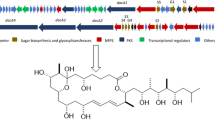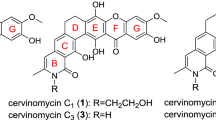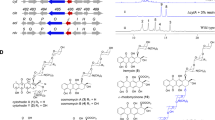Abstract
Chemical investigation of a previously unreported indigenous Australian Streptomyces strain MST-91080 has identified six novel analogues related to the oxazole-pendanted macrodiolide, conglobatin. Phylogenetic analysis of the 16S rRNA gene sequence identified MST-91080 as a species of Streptomyces, distinct from reported conglobatin producer, Streptomyces conglobatus ATCC 31005. Conglobatins B–E diverge from conglobatin through differing patterns of methylation on the macrodiolide skeleton. The altered methyl positions suggest a deviation from the published biosynthetic pathway, which proposed three successive methylmalonyl-CoA extender unit additions to the conglobatin monomer. Conglobatins B1, C1 and C2 exhibited more potent cytotoxic activity selectively against the NS-1 myeloma cell line (IC50 0.084, 1.05 and 0.45 µg ml−1, respectively) compared with conglobatin (IC50 1.39 µg ml−1).
This is a preview of subscription content, access via your institution
Access options
Subscribe to this journal
Receive 12 print issues and online access
$259.00 per year
only $21.58 per issue
Buy this article
- Purchase on Springer Link
- Instant access to full article PDF
Prices may be subject to local taxes which are calculated during checkout






Similar content being viewed by others

References
Brockmann H, Henkel W. Pikromycin, ein neues Antibiotikum aus Actinomyceten. Naturwissenschaften. 1950;37:138–9.
Omura S. Macrolide antibiotics: chemistry, biology, and practice. 2nd ed. San Diego: Academic Press; 2002.
Kamal A, Hahn G. 106. Chaksine. Part I. J Chem Soc. 1958;80:555–7.
Polborn KSW, Connolly JD, Huneck S. Structure of the macrocycle bis-lactone lepranthin from the lichen Arthonia impolita; an X-ray analysis. Z Naturforsch. 1995;50b:1111–4.
Kis Z, Furger P, Sigg H. Über die Isolierung von Pyrenophorol. Cell Mol Life Sci. 1969;25:123–4.
Fuska J, Ivanitskaya L, Horakova K, Kuhr I. The cytotoxic effects of a new antibiotic vermiculine. J Antibiot. 1974;27:141–2.
Kind R, Zeeck A, Grabley S, Thiericke R, Zerlin M. Secondary metabolites by chemical screening. 30. Helmidiol, a new macrodiolide from Alternaria alternata. J Nat Prod. 1996;59:539–40.
Kaiser H, Keller-Schierlein W. Stoffwechselprodukte von mikroorganismen. 202. Mitteilung. Strukturaufklärung von elaiophylin: Spektroskopische untersuchungen und abbau. Helv Chim. 1981;64:407–24.
Klassen JL, Lee SR, Thomas-Poulsen M, Beemelmanns C, Kim KH. Efomycins K and L from a termite-associated Streptomyces sp. M56 and their putative biosynthetic origin. Front Microbiol. 2019;10:1739.
Nakakoshi M, Kimura K-I, Nakajima N, Yoshihama M, Uramoto M. SNA-4606-1, a new member of elaiophylins with enzyme inhibition activity against testosterone 5 α-reductase. J Antibiot. 1999;52:175–7.
Yamada T, Kikuchi T, Tanaka R, Numata A. Halichoblelides B and C, potent cytotoxic macrolides from a Streptomyces species separated from a marine fish. Tetrahedron Lett. 2012;53:2842–6.
Yamada T, Minoura K, Numata A. Halichoblelide, a potent cytotoxic macrolide from a Streptomyces species separated from a marine fish. Tetrahedron Lett. 2002;43:1721–4.
Westley JW, Liu C-M, Evans RH, Blount JF. Conglobatin, a novel macrolide dilactone from Streptomyces conglobatus ATCC 31005. J Antibiot. 1979;32:874–7.
Hashida J, Niitsuma M, Iwatsuki M, Mori M, Ishiyama A, Namatame M, et al. Panowamycins A and B, new antitrypanosomal isochromans produced by Streptomyces sp. K07-0010. J Antibiot. 2012;65:197–202.
Huang W, Ye M, Zhang L, Wu Q, Zhang M, Xu J, et al. FW-04-806 inhibits proliferation and induces apoptosis in human breast cancer cells by binding to N-terminus of Hsp90 and disrupting Hsp90-Cdc37 complex formation. Mol Cancer. 2014;13:150.
Otoguro K, Iwatsuki M, Ishiyama A, Namatame M, Nishihara-Tsukashima A, Sato S, et al. In vitro and in vivo antiprotozoal activities of bispolides and their derivatives. J Antibiot. 2010;63:275–7.
Zhou Y, Murphy AC, Samborskyy M, Prediger P, Dias LC, Leadlay PF. Iterative mechanism of macrodiolide formation in the anticancer compound conglobatin. Chem Biol. 2015;22:745–54.
Lacey HJ, Gilchrist CL, Crombie A, Kalaitzis JA, Vuong D, Rutledge PJ, et al. Nanangenines: drimane sesquiterpenoids as the dominant metabolite cohort of a novel Australian fungus, Aspergillus nanangensis. Beilstein J Org Chem. 2019;15:2631–43.
Lacey HJ, Vuong D, Pitt JI, Lacey E, Piggott AM. Kumbicins A–D: bis-indolyl benzenoids and benzoquinones from an Australian soil fungus, Aspergillus kumbius. Aust J Chem. 2016;69:152–60.
Li H, Gilchrist CL, Lacey HJ, Crombie A, Vuong D, Pitt JI, et al. Discovery and heterologous biosynthesis of the burnettramic acids: rare PKS-NRPS-derived bolaamphiphilic pyrrolizidinediones from an Australian Fungus, Aspergillus burnettii. Org Lett. 2019;21:1287–91.
Lacey E, Tennant S. Secondary metabolites: the focus of biodiscovery and perhaps the key to unlocking new depths in taxonomy. Microbiol Aust. 2003;24:34–5.
Klindworth A, Pruesse E, Schweer T, Peplies J, Quast C, Horn M, et al. Evaluation of general 16S ribosomal RNA gene PCR primers for classical and next-generation sequencing-based diversity studies. Nucleic Acids Res. 2013;41:e1.
Sievers F, Higgins DG. Clustal Omega, accurate alignment of very large numbers of sequences. Methods Mol Biol. 2014;1079:105–16.
Labeda D, Goodfellow M, Brown R, Ward A, Lanoot B, Vanncanneyt M, et al. Phylogenetic study of the species within the family Streptomycetaceae. Antonie Van Leeuwenhoek. 2012;101:73–104.
Price MN, Dehal PS, Arkin AP. FastTree 2–approximately maximum-likelihood trees for large alignments. PLoS ONE. 2010;5:e9490.
Letunic I, Bork P. Interactive tree of life (ITOL) v3: an online tool for the display and annotation of phylogenetic and other trees. Nucleic Acids Res. 2016;44:W242–5.
Williams S, Goodfellow M, Alderson G, Wellington E, Sneath P, Sackin M. Numerical classification of Streptomyces and related genera. Microbiology. 1983;129:1743–813.
Spížek J, Málek I, Doležilová L, Vondráček M, Vaněk Z. Metabolites of Streptomyces noursei. Folia Microbiol. 1965;10:259–62.
Sujarit K, Kudo T, Ohkuma M, Pathom-Aree W, Lumyong S. Streptomyces palmae sp. nov., isolated from oil palm (Elaeis guineensis) rhizosphere soil. Int J Syst Evol Microbe. 2016;66:3983–8.
Schregenberger C, Seebach D. Synthesis and determination of the absolute configuration of the macrodiolide (+)-conglobatin. Tetrahedron Lett. 1984;25:5881–4.
Huang W, Wu Q-d, Zhang M, Kong Y-L, Cao P-R, Zheng W, et al. Novel Hsp90 inhibitor FW-04-806 displays potent antitumor effects in HER2-positive breast cancer cells as a single agent or in combination with lapatinib. Cancer Lett. 2015;356:862–71.
Dramae A, Nithithanasilp S, Choowong W, Rachtawee P, Prabpai S, Kongsaeree P, et al. Antimalarial 20-membered macrolides from Streptomyces sp. BCC33756. Tetrahedron. 2013;69:8205–8.
Acknowledgements
We thank Dr John Kalaitzis (MQ) for acquisition of NMR data and Dr Matthew McKay (MQ) for acquisition of HRMS data. Heather Lacey is the recipient of an Australian Government Research Training Program Scholarship. This research was funded, in part, by the Australian Research Council (FT130100142, FT160100233) and the Cooperative Research Centres Projects scheme (CRCPFIVE000119).
Author information
Authors and Affiliations
Corresponding author
Ethics declarations
Conflict of interest
The authors declare that they have no conflict of interest.
Additional information
Publisher’s note Springer Nature remains neutral with regard to jurisdictional claims in published maps and institutional affiliations.
Supplementary information
Rights and permissions
About this article
Cite this article
Lacey, H.J., Booth, T.J., Vuong, D. et al. Conglobatins B–E: cytotoxic analogues of the C2-symmetric macrodiolide conglobatin. J Antibiot 73, 756–765 (2020). https://doi.org/10.1038/s41429-020-0332-3
Received:
Revised:
Accepted:
Published:
Issue Date:
DOI: https://doi.org/10.1038/s41429-020-0332-3
This article is cited by
-
Yeppoonic acids A – D: 1,2,4-trisubstituted arene carboxylic acid co-metabolites of conglobatin from an Australian Streptomyces sp.
The Journal of Antibiotics (2022)


